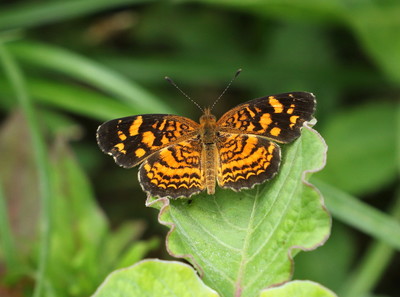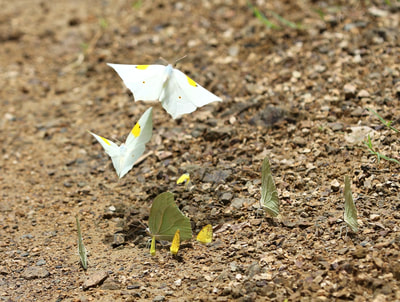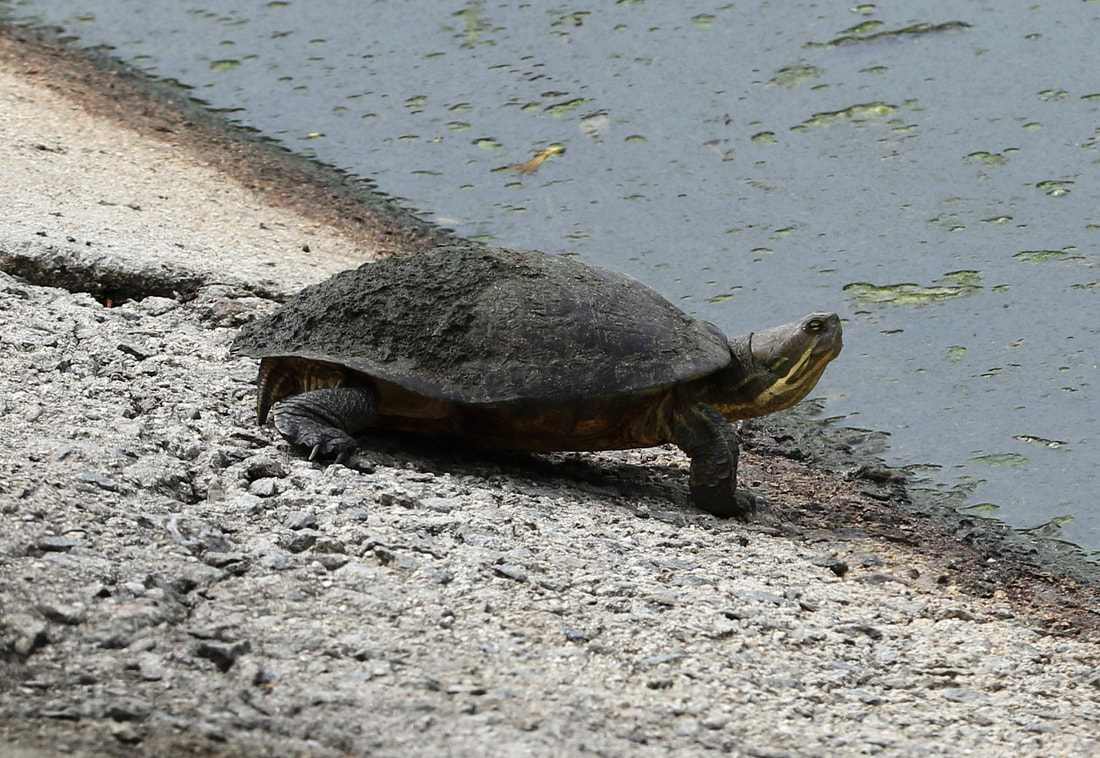|
We decided to explore a new area not far from the hotel today so we took the boat across the lake to where Raul was waiting and got him to follow behind us with the vehicle as we walked down the road and occasionally explored the trails on either side. There were more sunny periods today so we saw more butterflies, 43 species in all which isn't a big total but more than yesterday. There were several groups of mud-puddling whites and yellows comprising White-angled Sulphur Anteos clorinde, Sleepy Orange Abaeis nicippe and good numbers of Boisduval's Yellow Eurema boisduvaliana with its very distinctive wing-shape. But best of the butterflies was certainly a Red-striped Leafwing Siderone galanthis and this Antillean Mapwing Hypanartia paullus, still just the second that we have seen. We also saw saw lots of anoles today, most were Cuban Brown Anole Anolis sagrei distinguished by their red dewlap edged with yellow. Both sexes use this dewlap display as a threat to warn off other anoles from their patch. There can be some colour variation in this dewlap though, as can be seen on photo 3 where the yellow is more extensive. Photo 6 is interesting, it is clearly a pregnant female judging by the swollen abdomen and the broad pale line down the back is also indicative of a female but I've never seen one with a dorsal pattern like this before and the sandy brown head is usually an indication of female A. homolechis. Of the Odonata we saw Purple Bluet Enellagma coecum and another, a male, that I thought would prove to be one of the three Ischnura species that are found in Cuba, but it isn't so I'll have to wait for help with this one. Thank you to Juerg Carl Demarmels for coming back to me so promptly with the id as Caribbean Yellowface Neoerythromma cultellatum. This is a female as it lacks the yellow face of the males. And Juerg has kindly identified these dragonflies too which also had me stumped so thank you Juerg. The pyrale Epicorsia oedipodalis has larvae that feed on the foliage of fiddlewood and sea grape bushes. One of the many stars of today was this small but very beautiful toad. It's a Cuban Spotted Toad Peltophryne taladai and is a juvenile about an inch long. At this age they have very cryptic coloration in the grass but they can grow up to 160mm and turn brown and spotted as they get larger. What a beauty. In fact all the puddles and runnels in the road and tracks were all full of tadpoles and I suspect that many species were involved. We got back to the hotel for a late lunch and found two new butterfly species for the trip inside the hotel on the staircase window. They were Green Flasher Astraptes talus and Cuban Mercurial Skipper Proteides mercurius. We photographed them before releasing them. And then Doug spotted a snake hanging precariously on a ledge in one of the courtyards. It's a Giant Trope Tropidophis melanurus also known as a Dusky Dwarf Boa. I think I prefer this name as it is not big as snakes go and It is a constrictor. The last one we saw had caught a tree frog that it was busy squeezing the life out of before devouring. There are no dangerous snakes in Cuba, well not dangerous to humans anyway, but I wouldn't like to be a frog. But that wasn't an end to the reptile revelry as, following yesterday's discovery of a sphaero at the hotel we went in search of others and found quite a few including several Jamaican Stippled Sphaero Sphaerodactylus argus and a new species for us called Ashy Sphaero Sphaerodactylus elegans. We also saw several that resembled S. argus but were paler, yellowish and lacked any the white spotting. Perhaps these are just a different sex but they seemed rather structurally different too. In this area there are supposed to be just four of the 22 Cuban sphaero species. There are these two plus S. notatus that we have seen near Holguin, and another called S. oliveri and they don't resemble either of those. Later we checked out the sewage lagoon below the hotel which in the winter has lots of warblers and waders and waterthrushes but now in the summer there were just the resident birds like Killdeer, Cuban Green Woodpecker, West Indian Woodpecker, Cuban Tody, Cuban Trogon and Cuban Emerald.
0 Comments
Leave a Reply. |
Welcome to our Blog
Here we will post interesting news about what we and others have seen in Cuba. Archives
July 2024
Categories |


































 RSS Feed
RSS Feed